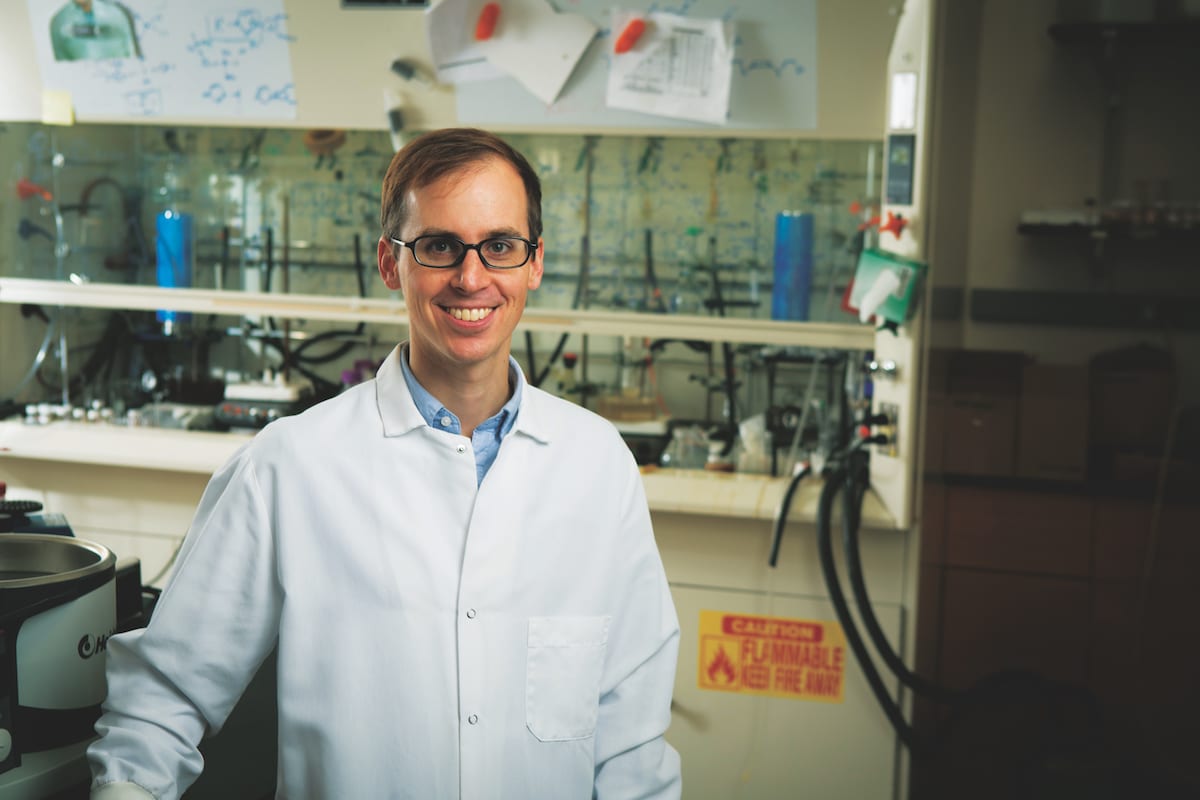
Timothy Cook and his team at the University at Buffalo have modified a metal-oxide cluster that could store power for homes, vehicles, or entire communities. [Photo: Douglas Levere]
Timothy Cook, University at Buffalo
One of the major barriers standing in the way of a reliable, large-scale clean energy system is storage. We can harvest clean energy anytime the sun shines or the wind blows, but how do we store it until we need to use it?
Enter Timothy Cook, an associate professor of chemistry at the University at Buffalo. His team partnered with the University of Rochester to modify a metal-oxide cluster, making its electrochemical properties almost twice as effective. The cluster could be used to store energy inside an energy storage device called a redox flow battery, which could then be used to power homes or vehicles.
To put it lightly, this tiny chemical cluster could become a very big deal. “Until we have have a way to store sustainable clean energy, we can’t fix any of the global problems that have to do with energy use,” Cook says.
gb&d: Walk us through how redox flow batteries work.
Timothy Cook: A lot of people are familiar with traditional batteries, like a lithium battery or even just a AA alkaline battery. They’re great for our cell phones, they’re great for our cameras and laptops and flashlights. But if you try to take a AA battery and power not a flashlight or a refrigerator, but a house when the sun goes down, you have to scale that up.
You can think about making a bigger battery like you’re working with graphics on a computer. You grab the edges and scale it up. Every single part of it has to get bigger, and every single part of it has to behave similarly—it can’t be affected by that scale-up process. And that’s really difficult to do with lithium ion batteries because there are a lot of components that go into it that don’t necessarily work as well on a larger scale. But if you dissolve the materials that hold the charge and create a solution, you have a much easier time making your battery bigger because you can simply make the tanks bigger that are holding the solution. So the “flow” part of redox flow refers to the fact that you quite literally have a liquid that flows around and stores the charge.
gb&d: What’s the ultimate goal of your research into redox flow batteries?
Cook: We pitch it as grid-scale energy storage, but I think the really cool longer-term vision behind all of this work lies in the idea that more energy hits the earth in one hour than human beings use in an entire year. That’s a little bit skewed—I think it’s actually an hour-and-a-half now, but still, there’s so much solar energy available and we use so little of it. That’s partly because we don’t have a good way to store it.
My vision would be personalized energy, where you would have a redox flow battery combined with your solar panel. You would keep charging your battery up during the day and then when the sun goes down you use this to power your house instead. You would be completely removed from the electrical grid, from that dependency.
gb&d: Why does this excite you?
Cook: A lot of problems we face as a global community really come down to energy use. It probably oversimplifies things to some extent, but when we think about the fact that there’s an increasing water crisis, it’s not so much that human beings waste water because water doesn’t really escape our atmosphere. It’s an energy problem. We don’t have a good way to remove the salt from the nearly undepletable source of water in the oceans. Or when we talk about meeting global food demand—it’s not really about growing more food, it’s about having enough energy to sustainably grow food.
When you start to trace all of these problems back to the common thread, the problem that really needs to be solved is an energy crisis. If we had clean sources of energy and they were truly inexpensive, we could do so many things as a society to improve quality of life.
gb&d: So what’s the next step?
Cook: I think it’s to partner with engineering groups and people who can take these molecules and really start to design practical devices around them and start to assess pathways to commercialization. We think we’ve identified systems that provide the basis for a library of really effective charge-carrying molecules, and we want to get these into prototypes and real devices. We want to see if this is something that could literally be attached to the house or put in someone’s backyard for energy storage.
Read more gb&d In the Lab features.

